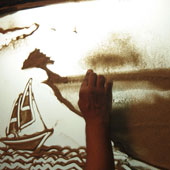Materials:
Experimenting with materials involves animating materials like sand, beads, buttons, fabric and more. Here the emphasis is on using materials that magically transform into figures and situations while they continue to look like the objects that they are. Everyday objects like rubber bands, foil, bubble wrap, rubik’s cube acquire new dimensions when framed and animated frame by frame. The animator relies on the viewers’ ability to imagine and transpose meaning onto those objects even if they seem impossible.
Sand Animation:
Sand animation involves creating images in sand and capturing the incremental changes frame by frame. Sand particles are moved around using various tools on a backlit box covered with a translucent glass as shown in figure.

The camera is mounted vertically above the box and the light is placed inside the box; creating silhouetted images in sand.

Because of its characteristics sand moves particle by particle creating a fluid animation.
Sand Animation can be done in Several Ways:
1. Moving the sand and capturing it frame by frame.
2. Performance animation, where the animator is seen transforming the images in camera.

3. Sandscapes are photographed and images created from them are animated using software.

Requirements:
1. Materials
2. Equipments
3. Softwares
1. Materials:
Sandbox - Back-lit box, Rinsed sand, brushes, spatula etc.
• Sandbox: back-lit box:

• Rinsed Sand:

2. Equipments:
Digital Camera with minimum 2GB memory card, tripod (camera stand), Table, Video Camera, Projector, Data transfer Cable, RG cable, white screen for projection.
3. Softwares:
Stills Capturing software (dragon), Video Editing Software (FCP, Adobe Premiere).
Types of Sand Animation:
• Frame by Frame
• Performance Animation
• Sand Cutout Animation
• Animation Techniques
The above types are explained in details in next session.

